|
|
Noble Metal/Semiconductor Photoactivated Electrodes for Direct Methanol Fuel Cel
ZHAI Chun-Yang, SUN Ming-Juan, DU Yu-Kou, ZHU Ming-Shan
2017 Vol. 32 (9): 897–903
 Abstract
Abstract(
928 )
 HTML
HTML(
7)
 PDF
PDF(367KB)(
1340
)
Direct methanol fuel cells (DMFCs) have received great attentions as clean energy due to their higher energy efficiency, easy transportation and environmental friendly. The activity and stability of the anode catalysts are the key factors of DMFCs. Recent studies show that usage of semiconductor materials as a supporter of traditional noble metal electrocatalyst greatly improves the electrocatalytic activity and stability of the electrode in DMFCs under light irradiation. In this paper, the research progress of photoactivated noble metal/semiconductor electrocatalyst for DMFCs in recent years is summarized including: (i) the mechanism of improving electrocatalytic performance of the noble metal/semiconductor electrode in DMFCs under light irradiation; (ii) the fabrication methods of noble metal/semiconductor electrode; and (iii) catalytic performance of the noble metal/semiconductor electrode. And the prospects and problems of the photo-responsive electrodes for DMFCs reactions are addressed briefly.
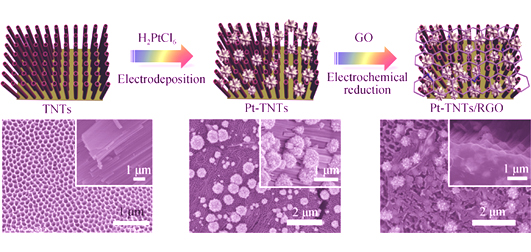
|
|
|
Graphene Loaded with Cluster Structural CoFe2O4 Particles and Its Li-Storage Performanc
LIU Shuang-Yu, XU Li, CHEN Xin, HAN Yu, LIU Hai-Zhen, SHENG Peng, WANG Bo, ZHAO Guang-Yao
2017 Vol. 32 (9): 904–908
 Abstract
Abstract(
677 )
 HTML
HTML(
1)
 PDF
PDF(394KB)(
1049
)
Oxidized graphite was used as carbon precursor, the preparations of graphene and cluster structural CoFe2O4 particles which homogeneously loaded on the grasphene were realized on the same time by one-step hydrothermal process combined with the bonding of oxygen-containing functional groups and metal ions. The microstructure observation shows that CoFe2O4 particles are composed of many primary particles. The unique structure of the composites helps graphene to develop its advantages of high conductivity and large specific surface area. Compared with pure CoFe2O4, the composites have excellent cycle stability and high rate performance. High-rate characteristics arise from high conductivity of graphene which enhances the overall conductivity and the diffusion of lithium in the composites. At the same time, the unique cluster structure and the confine of graphene inhibit the volume change of active nanoparticles in the charging and discharging process, and ensure the stability of active materials.
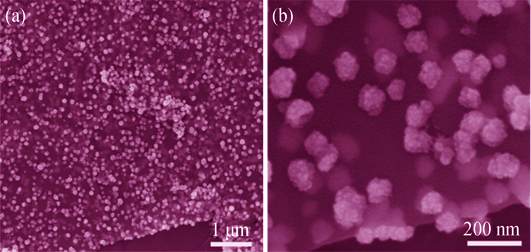
|
|
|
Performance of Coal-derived Spherical Porous Carbon as Anode Materials for Lithium Ion Batterie
LI Jun, CAO Ya-Li, WANG Lu-Xiang, JIA Dian-Zeng
2017 Vol. 32 (9): 909–915
 Abstract
Abstract(
704 )
 HTML
HTML(
8)
 PDF
PDF(601KB)(
1480
)
Spherical porous carbon nanomaterials is a promising candidate as anode materials for next-generation LIBs due to its large specific surface area which decreases the lithium ion transport distance. Spherical porous carbon nanomaterials with uniform morphology were prepared by arc-discharging followed by chemical activation using coal as precursor. The as-prepared spherical porous carbon samples were characterized by X-ray diffraction (XRD), scanning electron microscope (SEM), Raman spectrope (Raman), the nitrogen adsorption-desorption, galvanostatic charge and discharge method and so on. The result indicated that the spherical porous carbon materials have high specific capacity of 1188.9 mAh/g, which exceeds the commercial mesophase carbon spheres (372 mAh/g). Moreover, the spherical porous carbon nanomaterials also afford excellent cyclic stability and a reversible capacity of 844.9 mAh/g remains ever after 200 charge/discharge cycles at current density of 100 mA/g. The excellent electrochemical performance of coal based spherical porous carbon may be originated from the graded pore structure, which can provide more storage space for lithium ion, thus improving the capacity and cycle stability of the electrode.
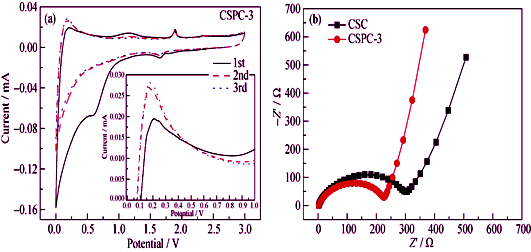
|
|
|
DMFC Anode Catalyst Fe3O4@Pt Particles: Synthesis and Catalytic Performanc
LI Min, LUO Yuan, XU Wei-Jia, LIU Jia-Xiang
2017 Vol. 32 (9): 916–922
 Abstract
Abstract(
633 )
 HTML
HTML(
5)
 PDF
PDF(474KB)(
1009
)
Fe3O4 magnetic core particles was prepared by hydrothermal method with a particle size of 150-300 nm, which showed good dispersibility. After amination of Fe3O4 particles by APTES, combined with in situ reduction of H2PtCl6 with NaBH4, we obtained Fe3O4@Pt with core-shell structure, and used it as a DMFC anode catalyst. The composition, morphology and structure of Fe3O4@Pt were characterized by transmission electron microscopy (TEM), X-ray diffraction (XRD), X-ray photoelectron spectroscopy (XPS), and energy-dispersive X-ray spectroscopy (EDS). The electrocatalytic activities of Fe3O4@Pt were also investigated by cyclic voltammetry (CV). As a result, the surface of Fe3O4@Pt particles mainly composed of Pt. The particle size of Fe3O4@Pt particles is between 200 nm and 300 nm. Atomic ratio between Fe and Pt is about 3:1. The prepared Fe3O4@Pt particles have a good stability. After 100 cycles, the cycle peak current density of the 101th’ cyclic voltammetry curve of glassy carbon electrode modified by Fe3O4@Pt in fresh 0.5 mol/L H2SO4+1 mol/L CH3OH aqueous solutions is 94.51% of the first cyclic voltammetry curve. The peak current density of pure Pt is only 90.73% compared with that of Fe3O4@Pt. The charge transfer between Fe3O4 and Pt improves the catalytic activity Fe3O4@Pt. As a result, this work demonstrates the potential of Fe3O4@Pt catalyst to replace Pt as the anode of DMFC in the future.
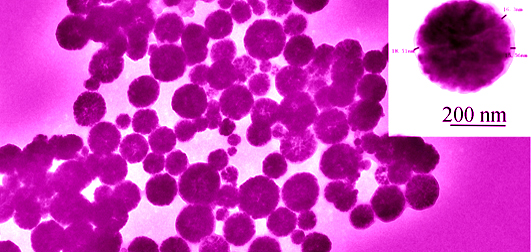
|
|
|
Birdnest-like CuCeZr Mixed Oxides: Synthesis and Excellent Catalysts for Diesel Exhaust Oxidatio
ZHAO Han, ZHOU Xiao-Xia, PAN Lin-Yu, CHEN Hang-Rong
2017 Vol. 32 (9): 923–930
 Abstract
Abstract(
568 )
 HTML
HTML(
5)
 PDF
PDF(598KB)(
1050
)
A series of ternary composite oxides CuCeZrOx calcined at different temperatures were prepared by a homogeneous precipitation method using urea as the precipitant. X-ray diffraction (XRD), N2 adsorption-desorption analysis, X-ray photoelectron spectroscopy (XPS), scanning transmission electron microscope (STEM), and temperature-programmed reduction (or desorption, oxidation) (TPR, TPD or TPO) measurements were utilized to investigate the influence of calcination temperatures on the physicochemical property and catalysis performance towards soot catalytic oxidation. The CCZ-350 (calcined at 350℃) sample exhibits the optimized catalysis performance: temperature at the maximum rate of soot oxidation (T50) = 407℃, under test conditions of space velocity = 12000 mL/(gcatalyst·h), c(O2) = 10vol%, c(NO) = 500×10-6, and mass ratio of (loosely contacted) catalyst/soot = 10/1. It is believed that theabundant high-reactive adsorbed oxygen species on CCZ-350 surface contribute much to its outstanding catalysis performance. Besides, CCZ-350 with a loose-packing and porous morphology favors its sufficient contact with soot, thus further benefiting the catatlytic activity towards soot combustion. More importantly, CCZ-350 also presents good water vapor and SO2 resistence performance as well as good capability of eliminating other pollutants in diesel exhaust at low temperatures (150-400℃), such as CO, C3H6 and C3H8.
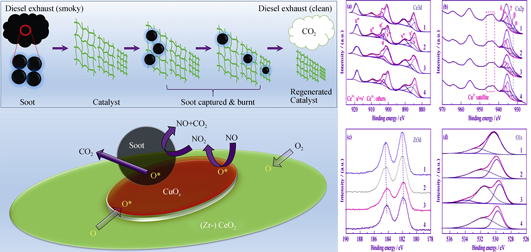
|
|
|
Synthesis and Performance of (Gd1-xYx)2Si2O7: Ce Mixing Crystal Scintillato
FENG He, XU Wu-Sheng, ZHANG Zhi-Jun, XU Zhan, XIAO Feng, ZHAO Jing-Tai
2017 Vol. 32 (9): 931–935
 Abstract
Abstract(
524 )
 HTML
HTML(
4)
 PDF
PDF(423KB)(
948
)
Polycrystalline samples of (Gd1-xYx)2Si2O7: Ce(x=0.1, 0.2, ...0.7, 1) were prepared through solid state reaction method. The serial samples were screened through scintillation luminescent efficiency i.e. X-ray excited luminescence spectra. The luminescence efficiency of (Gd0.5Y0.5)2Si2O7: 0.1%Ce sample was found to be the highest among all samples. The single crystal with this composition was grown by floating zone method. The structure, photoluminescence and scintillation luminescence properties of as grown sample were measured and discussed. The structure of the as grown single crystal was determined by XRD spectrum. Photoluminescence properties were evaluated in terms of photoluminescence excitation and emission spectra and photoluminescence decay curves. The X-ray excited luminescence spectrum, γ-ray multi-channel energy spectrum and scintillation decay curve were measured. According to the measurement result, the as-grown single crystal had orthorhombic structure. The main luminescence peak is around 362 nm. Two-exponential decay curve with fast component of 30 ns and slow component of 211 ns occurs in the PL process due to the Gd(6IJ)→Ce(5d3) nonradiative energy transfer. Slow component accounts for 87% of the total during the scintillation luminescence, which is resulted from the energy transfer and relative low Ce doping concentration. Light output of the as-grown single crystal sample is 90% of the cerium doped lutetium yttrium silicate scintillator.
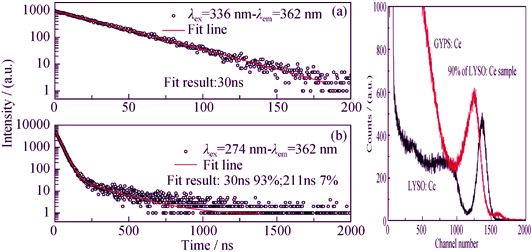
|
|
|
Synthesis and Photoluminescence Properties of Double Perovskite NaLaMgWO6: Eu3+ Red Phosphor
LI Gui-Fang, YANG Qian, WEI Yun-Ge
2017 Vol. 32 (9): 936–942
 Abstract
Abstract(
785 )
 HTML
HTML(
3)
 PDF
PDF(557KB)(
1294
)
Series of NaLa1-xEuxMgWO6 (0≤x≤1) novel red phosphors were successfully synthesized by the conventional solid state method. The crystal structure, morphology, and luminescence properties of NaLa1-xEuxMgWO6 phosphors were characterized by X-ray powder diffraction (XRD), scanning electron microscopy (SEM) and fluorescence spectra (PL), respectively. XRD results show that NaLaMgWO6 phosphor has monoclinic double perovskite structure with space group C2/m. The excitation and emission spectra show that NaLaMgWO6: Eu3+ phosphor can be effectively excited by near-UV (397 nm) and blue light (465 nm), and exhibits the strongest red emission peak located at 617 nm, which is ascribed to 5D0→7F2 transition of Eu3+ ion. The optimal doping concentration of Eu3+ is determined to be x=0.5. It can be confirmed that the dipole-dipole interaction plays an important role in the energy transfer in NaLaMgWO6: Eu3+ phosphors through the concentration quenching curve. In addition, Judd-Ofelt theory is employed to evaluate various radiative parameters, such as the refractive index, the J-O parameters (Ωλ) and the branching ration (β).
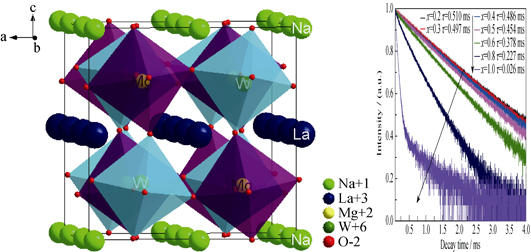
|
|
|
Spectral Properties of Pr, R3+: SrF2(R=Y, Gd) Laser Crystal
JU Qiang-Wen, MEI Bing-Chu, YU Hao, QIAN Xiao-Bo, WANG Jing-Ya, MA Feng-Kai, SU Liang-Bi
2017 Vol. 32 (9): 943–948
 Abstract
Abstract(
665 )
 HTML
HTML(
3)
 PDF
PDF(484KB)(
1111
)
A series of co-doped Pr, Y: SrF2 and Pr, Gd: SrF2 crystals were grown by the vertical Bridgman method and the influence of codoping ions on the lattice parameters and spectral properties of Pr: SrF2 crystal was studied. The results show that the doping of different kinds and concentration of the regulator ions can effectively improve the crystal absorption cross-section and emission intensity. Through changing the cluster structure and the local coordination structure of the luminescent center of the crystals, the law of different peaks’ emission intensities of Pr, R3+: SrF2(R=Y, Gd) crystals varies with each other. Most of the peaks’ emission intensities increase firstly and then decrease, and other few peak’s law is opposite or its emission intensity keeps nearly unchanged. Influence of the regulator ions on internal cluster and local structure of the crystal is testified based on the unit cell parameters and the fluorescence lifetime spectra. In general, the optical properties of Pr: SrF2 crystals are improved after codoping with the regulator ions, especially with 6.0at% Y3+ and 10.0at% Gd3+, which optical properties reach the best.
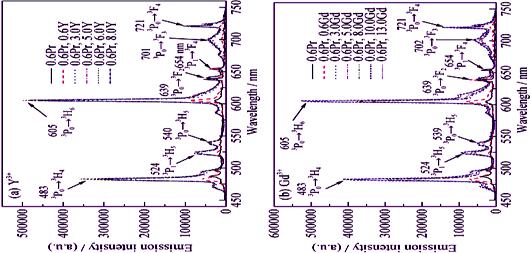
|
|
|
Preparation and Properties of NiO/PB Hybrid Electrochromic Fil
YUE Yan-Fang, LI Hai-Zeng, LI Ke-Rui, WANG Jin-Min, ZHANG Qing-Hong, LI Yao-Gang, CHEN Pei, WANG Hong-Zhi
2017 Vol. 32 (9): 949–954
 Abstract
Abstract(
820 )
 HTML
HTML(
20)
 PDF
PDF(483KB)(
1256
)
The vertically grown NiO hierarchical nano-structures were synthesized on FTO-coated glass using a crystal-seed-assisted hydrothermal technique. The NiO/PB film was obtained by the electrodeposition of PB on the NiO film. The crystal structures of the synthesis products were identified by X-ray diffraction technique and the microstructure and morphology of the films were characterized by field emission scanning electron microscope. The electrochemical property experiments were performed with an electrochemical workstation and the optical properties of the devices were recorded by Lambda 950. The NiO/PB film is composed of nanosheets and thus forming a porous structure. The porous structure could accelerate the interface electron kinetics between the film and electrolyte because its large electrochemical active area. Higher charge-insertion density of the NiO/PB film over the same period indicates faster kinetics, which means that the NiO/PB film possesses fast electrochemical response. Compared with the single NiO film, the NiO/PB film exhibits highly enhanced electrochromic performances, i.e. high optical modulation (46% at 700 nm without background correction), high coloration efficiency of 141 cm2/C at voltage of 2.5 V, and fast response time of 6 s and 5 s for bleaching and coloration states, respectively.
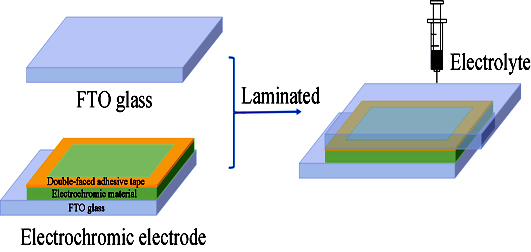
|
|
|
Graphene: Prepared by High Speed Shearing-assisted Exfoliation and Application in Thermal Conductive Silicon
SHI Zhi-Hui, LI Ying, YAN Lu, CAO Yun-Zhen
2017 Vol. 32 (9): 955–960
 Abstract
Abstract(
655 )
 HTML
HTML(
5)
 PDF
PDF(441KB)(
1181
)
Graphene dispersion was produced by centrifugation after exfoliating the graphite in aqueous solutions containing sodium cholate as a surfactant with high speed shearing machine. The exfoliated graphene (thickness≤4 layers) showing large lateral size of around 2-3 μm and high quality (ID/IG≈0.15) was characterized by atomic force microscopy (AFM), transmission electron microscopy (TEM), and Raman spectroscopy. After freeze drying, Graphene was added in the silver-silicone rubber to produce a hybrid graphene-metal thermal conductive silicone rubber, and steady-state heat flow method was applied to study the thermal conductivity of the composite. It was found that as filler loading fraction of graphene increased from 0 to 3vol%, thermal conductivity of siliver-silicone rubber dramatically improved from 4.9 W/(m·K)to 12.367 W/(m·K). This result suggests that little-defect graphene with few layers prepared by exfoliating can significantly enhance the thermal conductivity of silicone rubber by synergy effect when combined with silver powder.
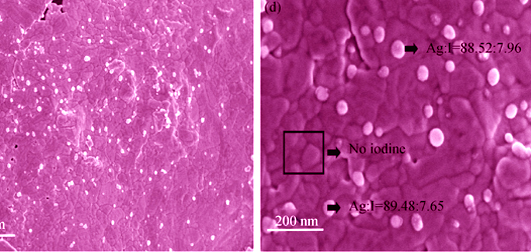
|
|
|
Oxidation Resistance and Residual Strength of Laminated ZrB2-SiC-G
Ceramics at 1300
LIU Xiao-Yan, WEI Chun-Cheng, NIU Jin-Ye, YANG Zan-Zhong, YU Chang-Xin
2017 Vol. 32 (9): 961–966
 Abstract
Abstract(
484 )
 HTML
HTML(
2)
 PDF
PDF(558KB)(
837
)
The laminated ZrB2-SiC-G ultra high temperature ceramic with different graphite interface layers were successfully prepared by tap-casting-stacking-hot press. The oxidation behavior at 1300℃ for 0.5-10 h and the influence of oxidation time on residual strength at room temperature were studied. In addition, the gain weight along with the change of oxidation time was observed, and phase and morphology were analyzed. The results show that the laminated ZrB2-SiC-G ultra high temperature ceramic prepared by adding 40vol%ZrB2 and 10vol% SiC in the graphite interface layer obtains the best mechanical properties with room temperature flexural strength of 670 MPa and the fracture toughness of 13.7 MPa·m1/2. After 10 h oxidation, the flexural strength is still up to 429 MPa, and the fracture toughness is still up to 10.25 MPa·m1/2. The excellent residual strength is attributed to the formation of a dense glass layer of SiO2 on the surface which prevents the internal material from being oxidized.
|
|
|
Damage Characteristics of SiC and B4C Ballistic Insert Plates Subjected to Multi-hi
CUI Feng-Dan, MA Tian, LI Wei-Ping, WU Guo-Qing
2017 Vol. 32 (9): 967–972
 Abstract
Abstract(
693 )
 HTML
HTML(
8)
 PDF
PDF(385KB)(
1151
)
The ballistic impact tests of SiC and B4C ballistic insert plates were conducted with 87-type 5.8 mm steel core projectile. Through the analysis on the depth of penetration in clay witness, bulge volume at the back of the ballistic insert plates, and impact damage being nondestructively tested by digital radiograph (DR), the damage characteristics of SiC and B4C ballistic insert plates after multi-hit were investigated. Meanwhile, the microstructures and mechanical properties of ceramic materials were also studied. The results show that SiC and B4C ballistic insert plates effectively resist 87-type 5.8 mm steel core projectile for 3 times and show good multi-hit capability. The depths of penetration in clay witness of B4C ballistic insert plate are comparable with SiC ballistic insert plate. Compared with SiC ballistic insert plate, the volume of bulge at the back of B4C ballistic insert plate is reduced by more than 35%, and the average diameter of the ceramic cone of B4C ballistic insert plate is increased by more than 30%. The impact energy of the projectile is effectively absorbed by the B4C ballistic insert plate, which attributes to the high hardness of B4C ceramic.
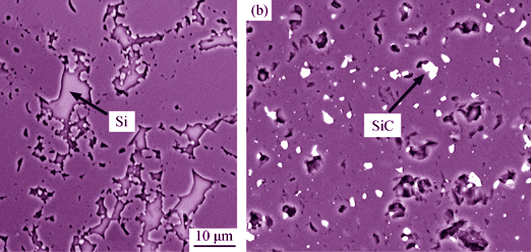
|
|
|
Thermal Shock Analysis of Surface Al-modified 7YSZ Nano-thermal Barrier Coatin
ZHANG Xiao-Feng, ZHOU Ke-Song, LIU Min, DENG Chun-Ming, DENG Chang-Guang, CHEN Huan-Tao
2017 Vol. 32 (9): 973–979
 Abstract
Abstract(
561 )
 HTML
HTML(
1)
 PDF
PDF(531KB)(
874
)
In order to improve the thermal shock resistance of 7YSZ nano-thermal barrier coating (TBC), bond coating NiCoCrAlYTa was prepared on simulated turbine blade by HVOF (high velocity oxygen flame). Subsequently, 7YSZ nano-ceramic coating was produced on bond coating as top coating. Al film was deposited on the surface of TBC samples. Then the Al-deposited TBCs were carried out by heat-treatment at different pressures (200, 250, 300 Pa). After that, the thermal shock tests of as-sprayed and Al-modified 7YSZ nano-TBC were taken from 1050 ℃ to atmospheric water with holding time of 10 and 5 min, respectively. Micrograph and microstructure evolution of the TBC sample were characterized before and after thermal shock. The results show that a loose top layer with Al nano-grains is formed on the TBC surface due to evaporation and condensation of Al film at vacuum pressure. Besides, with increase of heat-treatment pressure, the density of loose layer is increased. A dense Al2O3 layer was in-situ synthesized under the loose layer due to the reaction of Al and ZrO2. The Al-modified 7YSZ nano-TBCs heat-treated at different pressures has less spallation area than the as-sprayed TBCs after withstood 73 thermal shocks, showing better thermal shock resistance.
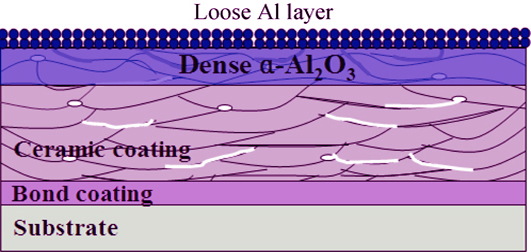
|
|
|
Process Parameters Optimization for Cd0.9Zn0.1Te Crystal Grown by Traveling Heater Metho
LING Yun-Peng, MIN Jia-Hua, LIANG Xiao-Yan, ZHANG Ji-Jun, YANG Liu-Qing, WEN Xu-Liang, ZHANG Ying, LI Ming, LIU Zhao-Xin, WANG Lin-Jun, SHEN Yue
2017 Vol. 32 (9): 980–984
 Abstract
Abstract(
589 )
 HTML
HTML(
5)
 PDF
PDF(403KB)(
992
)
To overcome the shortages of high growth temperature, low single crystal ratio and inhomogeneous composition of Cd0.9Zn0.1Te(CZT) crystal growth, the In-doped CZT crystal was grown by traveling heater method through optimized growth process parameters. High quality CZT crystals with diameter of 45 mm were grown after optimizing crystal growth temperature, temperature gradient at solid-liquid interface and in-situ annealing process, which had high resistivity, high transmittance, excellent uniformity, and low concentration of Te inclusions. Moreover, the patterns of wafer and powder X-ray diffraction showed that the crystallinity and the segregation of CZT were improved. Infrared transmittance spectra indicated that the level of impurities and defects was low in the crystal and the overall infrared transmittance of the crystal was about 60%. And UV-visible light absorption spectrum presented good uniformity of the crystal. Te inclusions in the crystal were observed by Infrared microscope, and it was found that Te inclusions were mainly distributed between 0-10 μm. In addition, mobility-life product for electrons of the crystal obtained was 8×10-4 cm2/V by direct current photoconductivity technique.
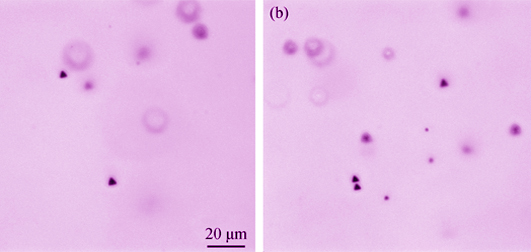
|
|
|
Technology of Preparing Diamond Wire Cut Multicrystalline Silicon Wafer Texture Surfac
WU Xiao-Wei, LI Jia-Yan, TAN Yi
2017 Vol. 32 (9): 985–990
 Abstract
Abstract(
638 )
 HTML
HTML(
2)
 PDF
PDF(518KB)(
1039
)
The texturization technology of multicrystalline silicon wafers is the key step of solar cell manufacture. Based on the acid etching technology widely used in industrial-scale manufacture, the influence of etching time and the components concentration of etching solution on the structure of texturization surface and reflectivity were investigated. In addition, the metal-catalyzed chemical etching technology was used to process the texture surface. The etching solution used in this method consists of hydrofluoric acid (HF) and silver nitrate (AgNO3). At the same time, the texture surface and reflectivity of silicon wafers etched by these two technologies were compared to select the ideal texture surface with uniform structure and low reflectivity. The results show that the best texture surface structure and reflectivity can be obtained under following reaction conditions: concentrations of HF and AgNO3 of 4.6 mol/L and 0.02 mol/L, respectively, reaction time of 90 min, and room temperature. The average reflectivity of silicon wafer after etching in this condition is 8 %, which is far lower than that by traditional method in current industry.
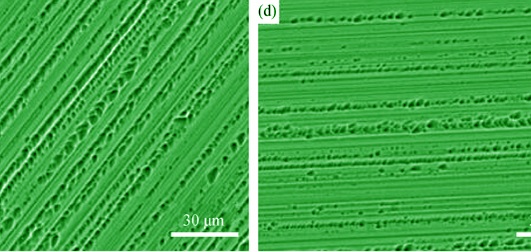
|
|
|
Preparation of TiC Nano-particles and Transformation of TiO2 via Microwave Carbothermic Reduction Rout
YUAN Zhen-Xia, LU You-Jun, CHEN Wei-Ye, WU Lan-Er
2017 Vol. 32 (9): 991–996
 Abstract
Abstract(
558 )
 HTML
HTML(
5)
 PDF
PDF(446KB)(
841
)
TiC powders were prepared via microwave carbothermic reduction in Ar with TiO2 and nano-carbon black as starting materials. Effects of TiO2 particle sizes, temperature and holding time on phase compositions, particle morphologies and TiC yields in the reaction products were investigated by means of X-ray diffraction (XRD) and scanning electron microscopy (SEM). Avrami equation was fitted to the change of TiO2 conversion with time at different temperatures. Results show that TiO2 powders with average diameters ranging from 40 to 400 nm were fully reduced at 1300-1400℃ for 30-40 min with TiC yield as high as 98.2%. TiC powder with uniform particle size less than 100 nm was obtained in case of reaction at 1400℃ for 30 min by using 40 nm TiO2 as starting material. Transformation curves of TiO2 were prepared for the synthesis of nano-TiC by microwave carbothermic reduction.
|
|
|
Low-cost Preparation of Graphene Papers from Chemical Reduction with FeI2/Ni2+ for Conductivity and Catalytic Propert
NAN Hui, WANG Wen-Li, HAN Jian-Hua, YIN Xue-Wen, ZHOU Yu, ZHAO Xiao-Chong, LIN Hong
2017 Vol. 32 (9): 997–1003
 Abstract
Abstract(
601 )
 HTML
HTML(
4)
 PDF
PDF(512KB)(
873
)
A novel method to produce reductive graphene oxide (RGO) with FeI2/Ni2+ applied as reductive agent was reported. This method provides a cheap, effective and environmentally friendly route for the large-scale production of RGO without losing its high conductivity and catalytic activity. An extremely high conductivity of 30231 S/m was obtained affer the optimized FeI2/Ni(NO3)2 solution treatment. The enhancement of bulk conductivity was clue to the promotion of the nucleophilic substitution reaction induced by Fe2+ (a strong Lewis acid). Ni2+ was introduced to optimize the reductive process by reducing the concentration of hydrogen ions, which would inhibit the hydrolysis of Fe2+. Furthermore, a high cathodic peak current density was observed when applying the free-standing RGO paper as counter electrode in I-/I3- electrolyte system, indicating the high catalytic performance of the RGO paper and providing electron transporting pathway. These outstanding features exhibit a promising prospect of application in solar cells.
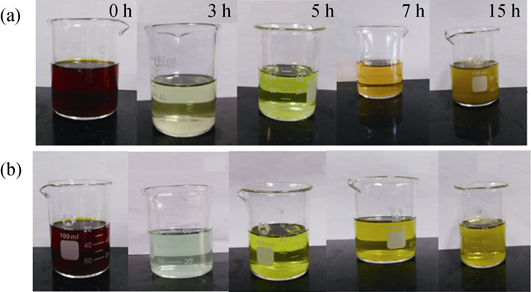
|
|
|
Effects of Sintering Aids (Y3+, La3+ and Mg2+) on the Optical Transmittance of Translucent Alumina Ceramic
YUAN Kang, LIAO Qi-Long, WANG Fu, DAI Yun-Ya, HUANG Jin-Shan
2017 Vol. 32 (9): 1004–1008
 Abstract
Abstract(
716 )
 HTML
HTML(
3)
 PDF
PDF(450KB)(
925
)
Translucent Al2O3 ceramics were prepared by vacuum sintering using Y3+, La3+ and Mg2+ as sintering aids which were introduced via chemical precipitation. Effects of the sintering aids on microstructure, relative density and optical transmittance of the translucent Al2O3 ceramics were investigated. The results show that the sintering aids are homogeneously dispersed in translucent Al2O3 ceramics. The optimal amount of the sintering aid introduced is Mg2+ (0.15wt%), Y3+ (0.05wt%) and La3+ (0.05wt%), and the corresponding sample shows the highest total forward transmittance (above 80% in the wavelength range of 350-800 nm). Moreover, the addition of Y3+ could promote grain growth and decrease porosity, thus the optical transmittance of the translucent Al2O3 ceramics is enhanced.
|
|